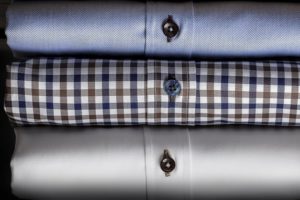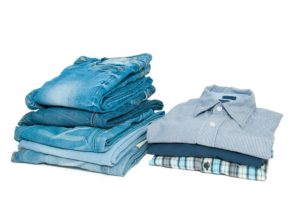Poplin vs. Twill – Everything You Need To Know
Jump To:
When it comes to men’s fashion, more formal dress shirts tend to be made from materials such as cotton, wool, silk, or linen. To build these high-quality dress shirts in a comfortable, durable, and fashionable way, the specific way the shirt fabric is woven is an important key factor. Check out flannel vs plaid.
Two of the most popular fabrics for dress shirts are poplin and twill. While quite similar in some ways, these fabrics have significant enough differences between the two that the distinction is worth your time. If you’re looking to know more about the different fabrics available for clothing, check out this guide. It covers poplin and twill fabric in detail along with many others!
Poplin Fabric

Poplin, which is also sometimes referred to as tabinet, is a delicate and fine but dense fabric with a horizontal warp with a vertical weft. It is most often cotton, wool, or silk. It is known to be quite strong due to the weaving technique, and it usually has a corded surface due to the fine horizontal ribs running through the fabric.
The poplin weaving technique provides comfort and feels that are crisp and shiny, making it a great option for men’s dress shirts. In addition, poplin is also used for sportswear, raincoats, and dresses for women. This cool, cool material is also very breathable and lightweight due to its organic nature, which means you won’t overheat or feel trapped as you can in other fabrics.
Poplin Origin
Since poplin uses two different thicknesses for warp and weft, the tight weave and pale horizontal ribbing are what give poplin its beloved look and texture. As for its history, the poplin dates back to 15th century France in the city of Avignon. It was originally called papelino, and because at that time, the Pope had taken up residence in Avignon, this fabric was intended to honor the Pope himself.
A little further into the future, the poplin was used as the primary fabric for the British and American servicemen. This was decided because the poplin had the ability to withstand the ordeal and tears of battle while keeping soldiers cool.
This incredibly durable fabric is resistant to everything from a tear to a stain while remaining smooth to the touch. Plus, the tight weave of the poplin allows the fabric to drape perfectly over the skin, making it a very flattering fabric for any body type. Although it is very breathable and lightweight, poplin can also be warmer for the colder months by using silk and wool threads rather than cotton. However, it is usually not the fabric that is chosen to design winter clothing.
Twill fabric

Twill is the most common fabric used for clothing because its weave makes it a very durable material. This kind of cloth has many different names, including denim, gabardine, and houndstooth, making it easy to pick out in stores while also versatile enough to be worn everywhere from formal events to outdoor adventures like hiking or camping.
An offset creates these diagonal lines in the warp threads. As well as being quite thick and durable, the texture and weave of the twill make it difficult for stains to permeate the fabric, making it a real winner for those who want to avoid an embarrassing incident during a more formal event.
Twill Origin
Herringbone is one of the oldest textiles known to man. Pieces discovered in Ireland date back to 600 BC, and ancient artifacts have been found all over Europe, Asia, and even North America during this time period. This proves that herringbone fabric has a rich history across many countries, not just within European borders.
Back then, twill was mostly used for its functionality due to the durability and thickness of the fabric. It was considered the ideal material for work-related tasks and roles and was primarily designed for clothing that withstands heavy use.
Twill has always been seen as a versatile textile, but now it is even being considered formal. From houndstooth jackets to jeans and everything in between, twill can be found anywhere on the spectrum, from casual to dressy.
Poplin vs. Twill

When it comes to dress shirts, poplin and twill are wonderful options. These fabrics are durable enough to last in many uses, and the look and feel of both fabrics can fit into a formal or business setting.
Poplin In Hot Weather
However, if you need a shirt that will keep you cool and comfortable in hot weather, poplin is the best option because the material is more breathable and lightweight than twill.
The suit’s weight makes a difference when choosing your shirt, so if you’re wearing something heavier like formal wear for an interview or other more formal event, then poplin shirts are recommended.
Twill For Cool Weathers
In turn, a twill is a great option when you need something warmer or stronger. It’s much thicker and less breathable than poplin, allowing you to layer extra layers when needed. Plus, the diagonal pattern running through the shirt pairs perfectly with a subtle or understated pattern on your dress shirt, giving your outfit some flair for more formal occasions. As stated earlier, twill can also be used in jeans and jackets to more formal dress pants.
These similar but different fabrics are a must-have for any man’s closet, and having a few options for both various events and weather conditions is never a bad idea. Remember that while they may look almost identical, your experience wearing them will not be the same.
Is poplin lighter than twill?
This creates different properties and distinct differences. Both weaves are soft and durable, but poplin is light, thin and smooth, whereas twill is thicker and heavier. They are strong materials, however poplin is often softer and more breathable.
Which is better cotton or poplin?
Poplin is a durable, lightweight cotton. It’s not dissimilar to quilting cotton, though of a lighter heft and less prone to creasing. It has a tight weave, which in my experience can make it surprisingly tricky to sew with: it often seems to resist a needle. … It’s finer than poplin, with a crisp hand.
What is better twill or cotton?
The major benefits of cotton twill relate to its durability. It is extremely tare-resistant compared to other types of fabric. Cotton twill is also resistant to wrinkles, creases and has a major pro of showing less dirt and stains. However, one negative is that its heavier than other types of cotton and fabrics.
Is poplin a good fabric?
Poplin is a strong fabric that can stand up to the washing machine or heavy wear. It can also hold its shape fairly well, making it wrinkle resistant, and therefore a popular choice for home decor items like upholstery fabric, tablecloths, and quilting.
Can you wear poplin in the winter?
Even though this fabric is durable, it won’t make you warm in winter. Poplin can be worn with a lining, still, it doesn’t work for winter apparel. Poplin is very popular in summer wear, but if you live in a cold climate, there are more suitable options for you. The fabric is too thin.
Is twill good for summer?
There are a number of variations on the twill weave, but in general it’s used to make a garment sturdy and even. That gives it a nice drape, but can make it hot in the summer. While common (and cheap) as “summer wear,” it’s often not the best choice.
Is poplin a stiff fabric?
Despite being thin, Poplin is incredibly easy to work with, thanks to its smooth face and ability to hold its shape well. You still may want to stiffen it up beforehand though, as although crisp, it can be quite slippery.
What kind of material is poplin?
weave cotton fabric Poplin, also known as tabbinet, is a plain-weave cotton fabric with very fine horizontal “ribs,” or yarns, that results in a strong, crisp fabric with a silky, lustrous surface. Poplin is commonly used in men’s and women’s shirts, women’s dresses, and items like sportswear and raincoats.
What is poplin good for?
It is an all purpose fabric due to its lightweight feel and flat surface. Mostly used for making clothing such as woman’s dresses and blouses, men’s shirts and pants but also for elegant tablecloths. Even children’s wear because poplin is soft to touch and launders very well without too many wrinkles.
Which is better twill or polyester?
Both the twill weave and polyester content make Polyester Twill fabric more durable and insulating.
Is twill a breathable fabric?
Lining Twill Often woven with silk, it is lightweight, smooth, shiny and attractive. Lining twill is water-resistant and shrink-resistant. It can also be easily printed upon. Twill fabric is durable, soft, breathable and pliable making it a great choice for Hullo.
Is twill like denim?
Twill refers to a wide range of fabrics with the same weave pattern. Basically, all denim is twill, but not all twill is denim!
Is poplin woven or knit?
Poplin is now made with wool, cotton, silk, rayon, polyester or a mixture of these. Since it has a plain under/over weave, the fabric displays a plain-woven surface with no ribbing if the weft and warp threads are of the same material and size. Shirts made from this material are easy to iron and do not wrinkle easily.
Is poplin the same as 100% cotton?
Poplin fabric is characterised by its distinctive ribbed texture and tightly closed weave. … Today, poplin fabric is primarily made from 100% real cotton, making it lightweight but still retaining the strength.
How much does poplin cost?
Depending on the fiber content, poplin is an inexpensive fabric. Poplin made from 100% cotton can range from $2.50 to $7.50 per yard.